 Abraham Lincoln
If given the truth, the people can be depended upon to meet any national crisis...
Abraham Lincoln
If given the truth, the people can be depended upon to meet any national crisis...
 Guildford news...
for Guildford people, brought to you by Guildford reporters - Guildford's own news service
Guildford news...
for Guildford people, brought to you by Guildford reporters - Guildford's own news service
Opinion: When Guildford Really Was A Dirty Old Town!
Published on: 28 Feb, 2021
Updated on: 4 Mar, 2021
By David Rose
It’s easy to look at old photographs and say “wasn’t it so much nicer back then”, and “what a shame they pulled those lovely buildings down”.

A very early photo of Guildford High Street from about 1860 with the cattle market in full swing. The market was moved to North Street five years later. Picture: Guildford Institute collection. Click on all pictures to enlarge in a new window.
Having studied what’s probably a few thousand vintage photos of Guildford over many years, I am strongly of the opinion it really wasn’t better in the “olden days”.
Parts of Guildford were, in the 19th century and into the 20th century, filthy places.
The photos here reveal what it was really like – a time when buildings were blacked by smoke and pollution, animal excrement smothered poor road surfaces, and the working-classes often living in run-down houses whose owners may well have been reluctant to undertake repairs and upkeep.
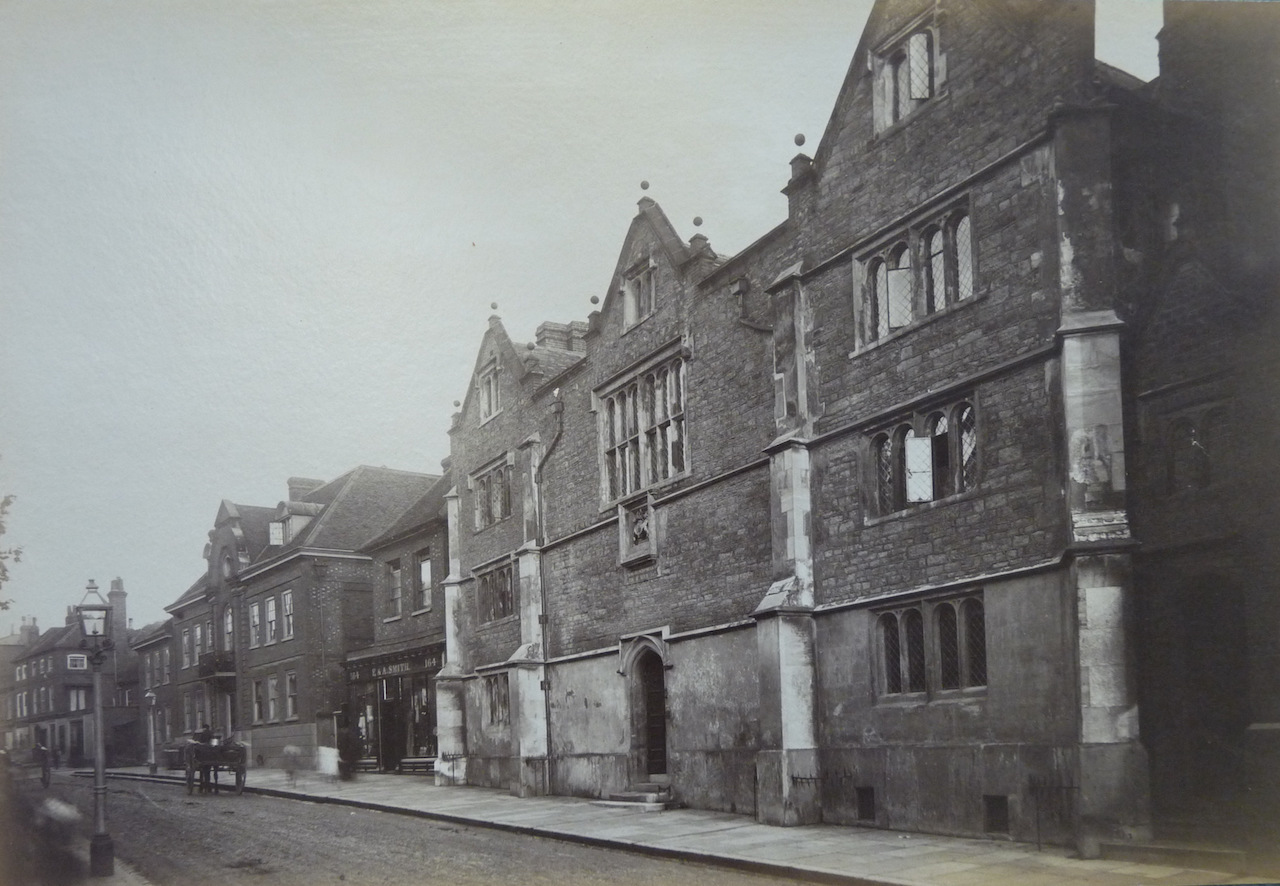
When the Royal Grammar School looked decidedly grey with soot and smut. Guildford Institute Collection.
When such buildings were at the point of falling down, it was easier back then to pull them down and rebuild. Our forebears may not have understood their historical importance and just didn’t have the means or finance to conserve and save them.
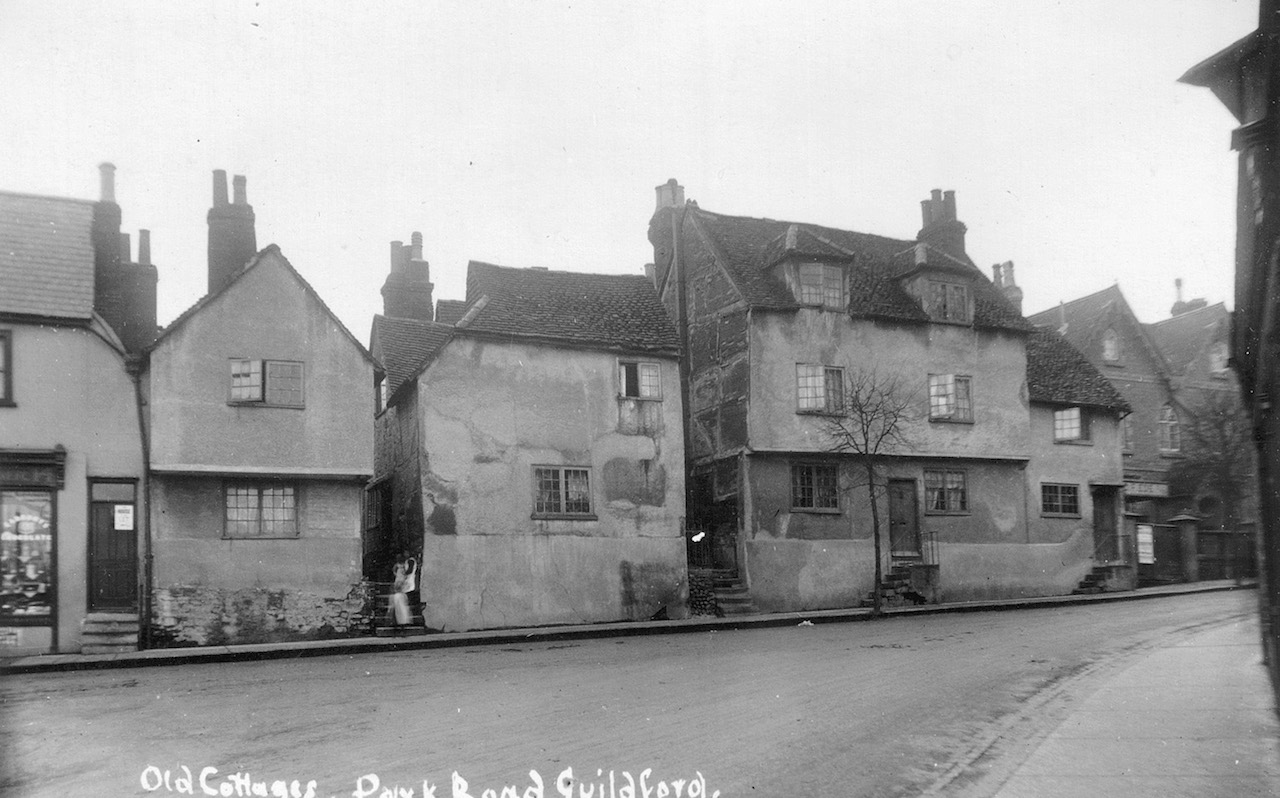
Park Street cottages featured on a picture postcard in the early 1900s looking delipidated then. They were eventually demolished in the 1950s, surely unfit for human habitation?

The last cattle market in North Street in 1896 before it moved to Woodbridge Road. Guildford Institute collection.
We can see the dirt and grime in these old photos, but we have to imagine the stench! All the smells of the cattle market when it was in the town centre, first in the High Street, then North Street and then Woodbridge Road.
 The smells wafting from the various breweries. Those at the turn of the 20th century being Friary, Holroyd & Healy’s Brewery, between Onslow Street and Commercial Road; Lascelles, Tickner & Co’s Castle Brewery, between Portsmouth Road and Bury Street; and Crooke’s Brewery, just over the Town Bridge and opposite St Nicolas Church.
The smells wafting from the various breweries. Those at the turn of the 20th century being Friary, Holroyd & Healy’s Brewery, between Onslow Street and Commercial Road; Lascelles, Tickner & Co’s Castle Brewery, between Portsmouth Road and Bury Street; and Crooke’s Brewery, just over the Town Bridge and opposite St Nicolas Church.
Add to those the smells and pollution from the gasworks off Woodbridge Road, and later the electricity works first off Onslow Street and then the power station in Woodbridge Road.
There was also the smoke, fumes and pollution from steam engines, particularly from Guildford’s engine shed.
The River Wey Navigation had a duel use after ordinary people began to have a little more leisure time from about the 1870s. Upstream, rowing boats could be hired, and the walk along the towpath was enjoyed. Children learned to swim at “Three Oaks” beyond St Catherine’s Lock – presumably the water was cleaner there and less rubbish thrown in.

Industry reigns: Looking downstream from the Town Bridge in the early 1900s with Crooke’s Brewery on the left. Issued as a picture postcard, and featured in David Rose’s book Lost Guildford.
On the other hand, there was industry and muck along the navigation close to the town centre, including a foundry, timber yards, coal merchants, the aforementioned Crooke’s Brewery, and other small industries such as clay tobacco pipe makers.
Night photography was a very unusual subject more than 100 years ago. That’s probably because after dark the town centre was an extremely gloomy place.
Guildford town centre did have gas lighting, but the pall of light from its lamps would have been dull compared to today’s brilliant electric lights from street lamps and the light flooding onto the streets from shops and businesses.
Folk singer Ewan McColl wrote the song Dirty Old Town about Salford, Manchester. Though Guildford was a world away from the harsh realities of more industrial parts of Britain, it was definitely grubby in its own way.
And a few more photos of the “bad old days”…
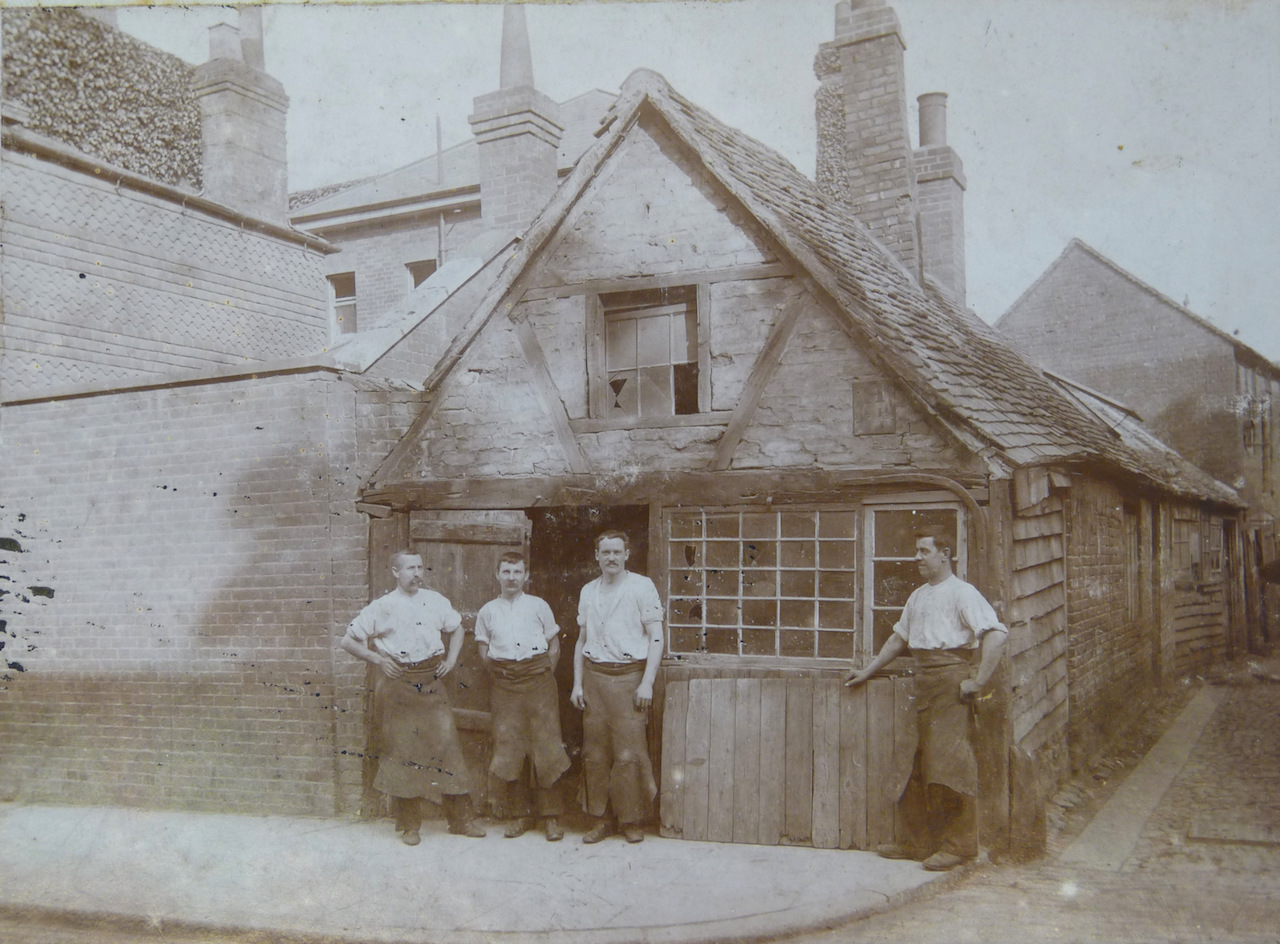
Lymposs’s smithy in the upper High Street in the 1900s. It’s a wonder the building hasn’t collapsed. A bit ironic perhaps as this was between the entrances to today’s Eastgate Gardens and Alexander Terrace, and with a row of empty shops there at the time of writing dubbed ‘The Street of Doom’. Guildford Institute collection.

Ram Corner at the junction of High Street, Upper High Street and North Street. As well as the horse dung in the road, the Ram pub itself was demolished in 1913 to make way for necessary road widening as motor-traffic was rapidly increasing.
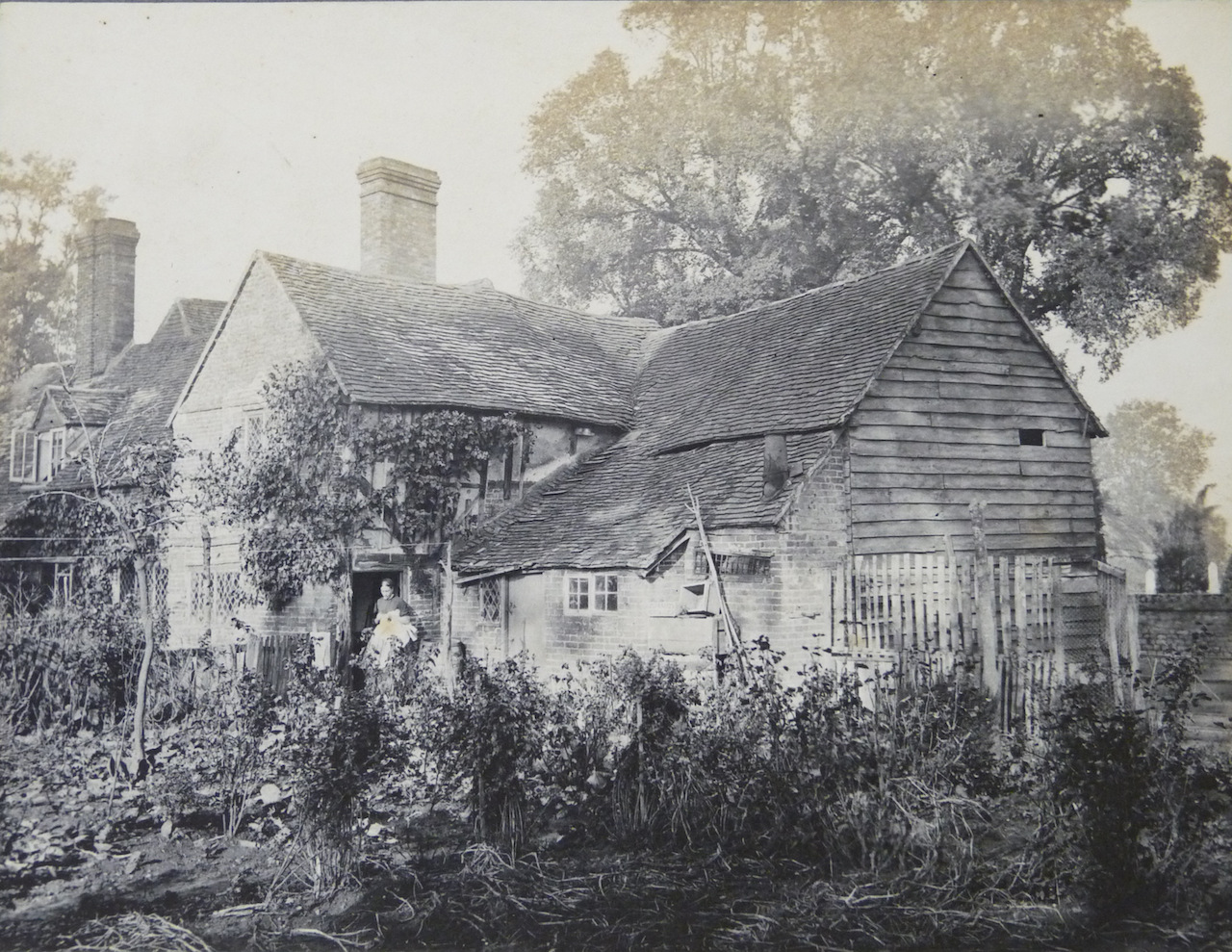
The above and below cottages do exist, they are at the Stoke Road end of Joseph’s Road. But these photos from the Guildford Institute’s collection are an excellent example of the slum housing in which some Guildford people lived. It’s not surprising that many such homes had to be demolished.
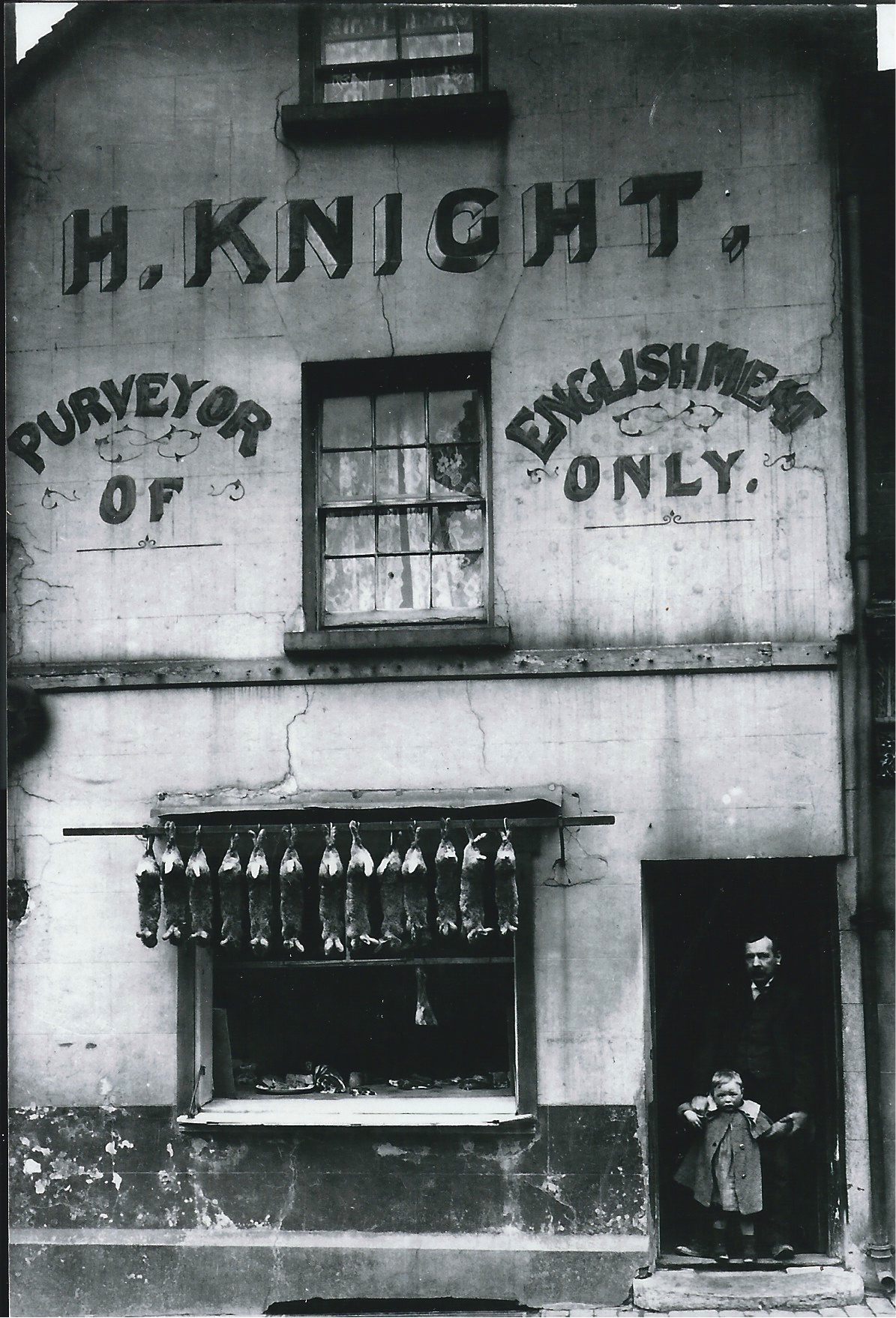
H. Knight’s butcher’s shop in Chertsey Street. Today the building is the right-hand side of the Tup pub (formerly the Spread Eagle). The picture is a copy given to David Rose and featured in his talk Guildford’s Lost Shops.
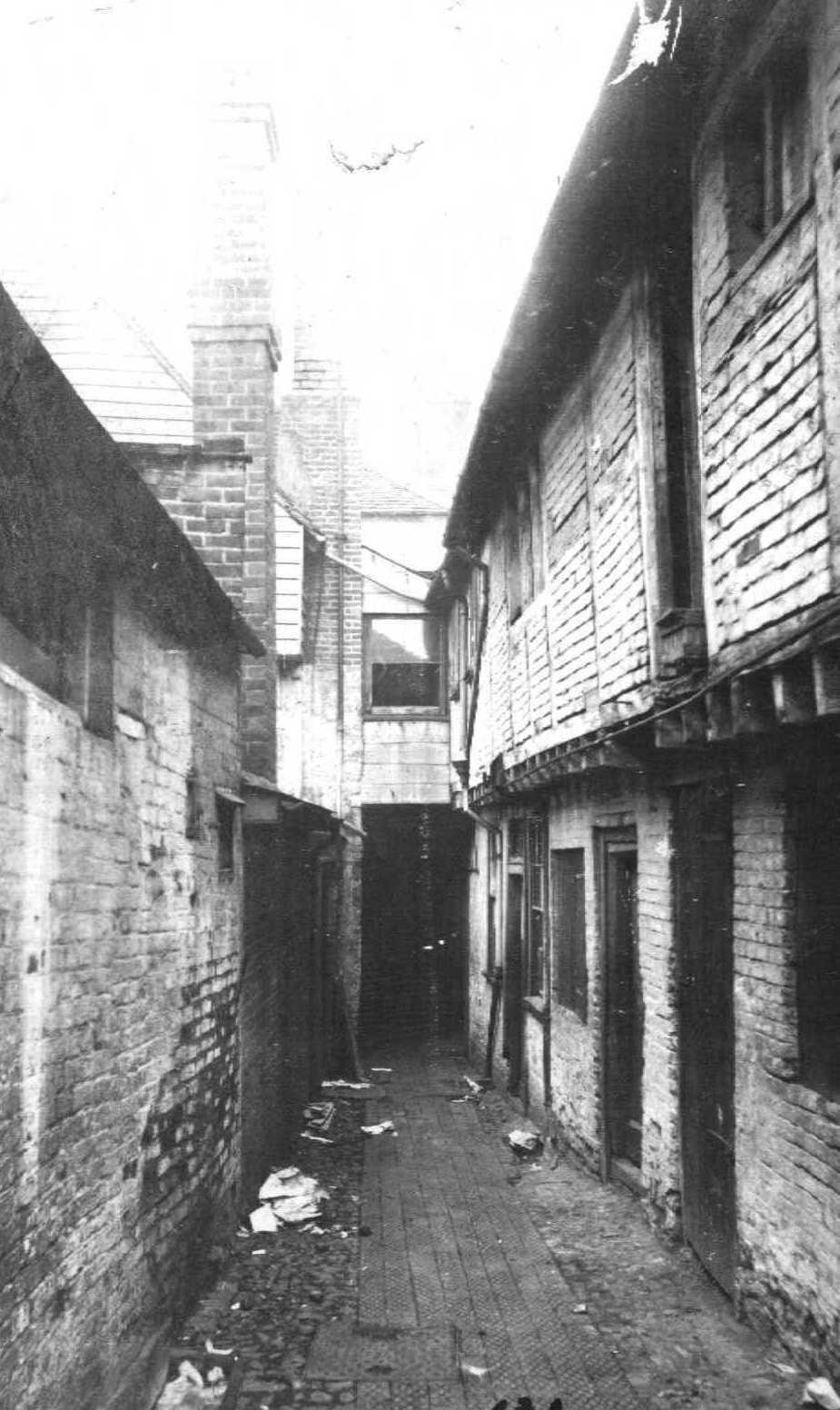
A passageway behind what was then 113 High Street, Guildford and much neglected buildings by the look of them. Number 113 is now 68 High Street, on the corner of Chapel Street (right-hand side). Guildford Institute Collection.
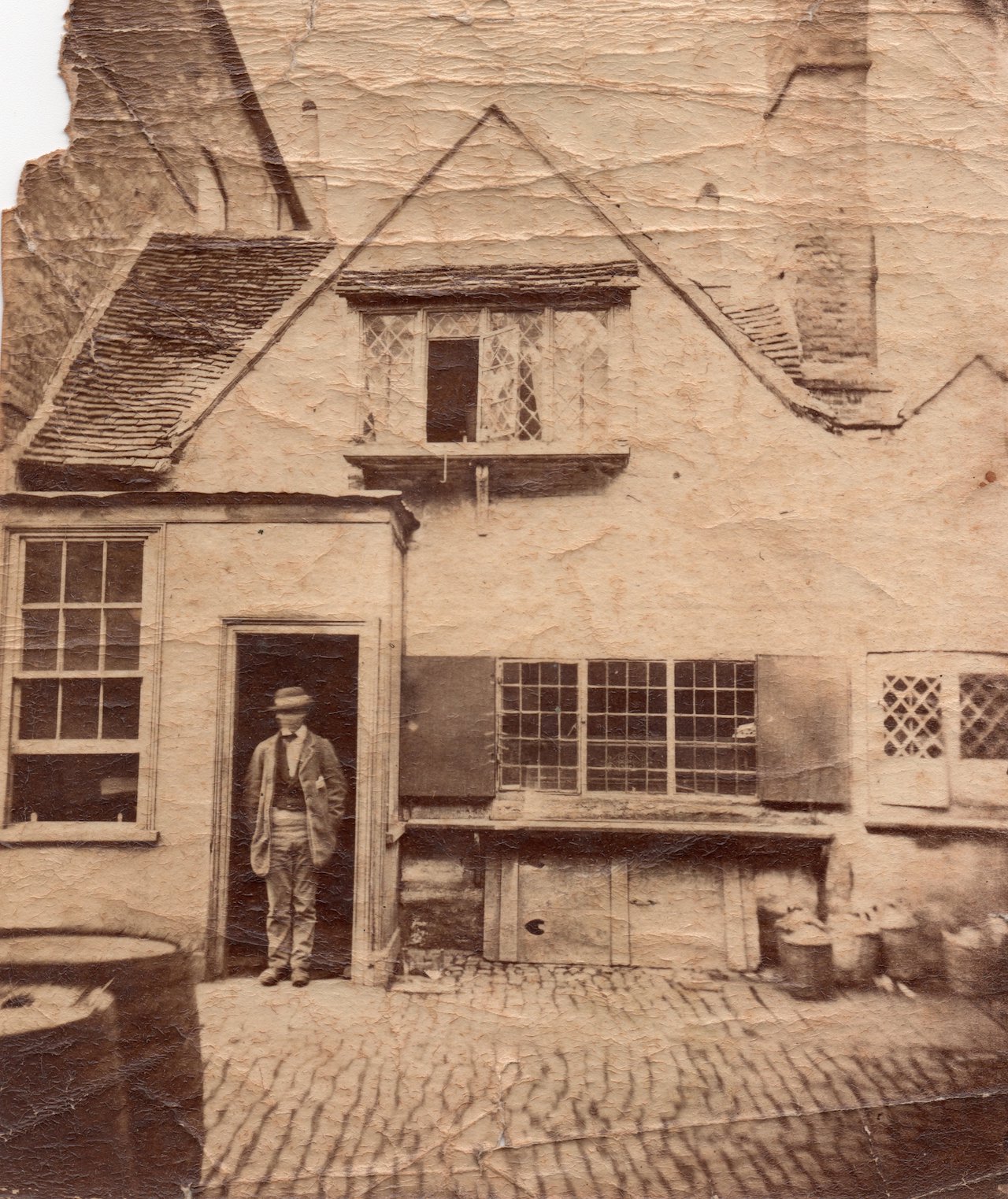
Perhaps this building should have been saved. Reputed to have been the birthplace of Archbishop George Abbot, it was later an alehouse called the Three Mariners and later still within Crooke’s Brewery. It was demolished in the 1860s. At least people can park there today as it’s the car park next to the George Abbot pub! Guildford Institute collection.
You can discover many more old photos of Guildford by visiting the Guildford institute’s library in Ward Street when it re-opens, hopefully in the near future. Its entire collection has been digitised.
Guildford Museum has been also digitising its collection. A selection of vintage Guildford town centre street scenes from its collection can now be seen on Guildford Borough Council’s website. Click here.
Responses to Opinion: When Guildford Really Was A Dirty Old Town!
Leave a Comment Cancel reply
Please see our comments policy. All comments are moderated and may take time to appear. Full names, or at least initial and surname, must be given.Recent Articles
- City’s Match Postponed
- Letter: Shaping Guildford’s Future and Meeting the New Housing Uplift
- Mayor’s Diary: January 10 – 26
- County Council Elections ‘Must Go Ahead’ Say Surrey Council Leaders
- Notice: Become a Tech Angel
- Guildford’s Angels Receive National Lottery Grant
- National Trust Announce Funding Secured, At Last, for Weir Bridge Repair
- Letter: Time for Action to Repair the Tumbling Bay Bridge and Restore the Wey Towpath
- MP Says Thames Water Have ‘Done Nothing’ Despite Residents Reporting Sewage Spill
- Letter: Residents & Independents Group Calls for More Time as Local Government Reorganisation Looms


Recent Comments
- David Roberts on Local Political Reactions to County Council’s Proposal to Postpone Elections
- RWL Davies on Surrey Police Spent £23 million on Aborted Move to Leatherhead
- Claire Morris on Following Debate, SCC Leader Is Writing to Request Postponement of May Elections
- Mike Smith on ‘Devolution’ is Happening ‘Whether We Like It or Not’ Warns County Council Leader
- Jim Allen on Following Debate, SCC Leader Is Writing to Request Postponement of May Elections
- Peter Hyde on ‘Devolution’ is Happening ‘Whether We Like It or Not’ Warns County Council Leader
Search in Site
Media Gallery
Dragon Interview: Local Artist Leaves Her Mark At One of England’s Most Historic Buildings
January 21, 2023 / No Comment / Read MoreDragon Interview: Lib Dem Planning Chair: ‘Current Policy Doesn’t Work for Local People’
January 19, 2023 / No Comment / Read MoreA3 Tunnel in Guildford ‘Necessary’ for New Homes, Says Guildford’s MP
January 10, 2023 / No Comment / Read More‘Madness’ for London Road Scheme to Go Ahead Against ‘Huge Opposition’, Says SCC Leader
January 6, 2023 / No Comment / Read MoreCouncillor’s Son Starts Campaign for More Consultation on North Street Plan
December 30, 2022 / No Comment / Read MoreCounty Council Climbs Down Over London Road Works – Further ‘Engagement’ Period Announced
December 14, 2022 / No Comment / Read MoreDragon Interview: GBC Reaction to the Government’s Expected Decision to Relax Housing Targets
December 7, 2022 / No Comment / Read MoreHow Can Our Town Centre Businesses Recover? Watch the Shop Front Debate
May 18, 2020 / No Comment / Read More






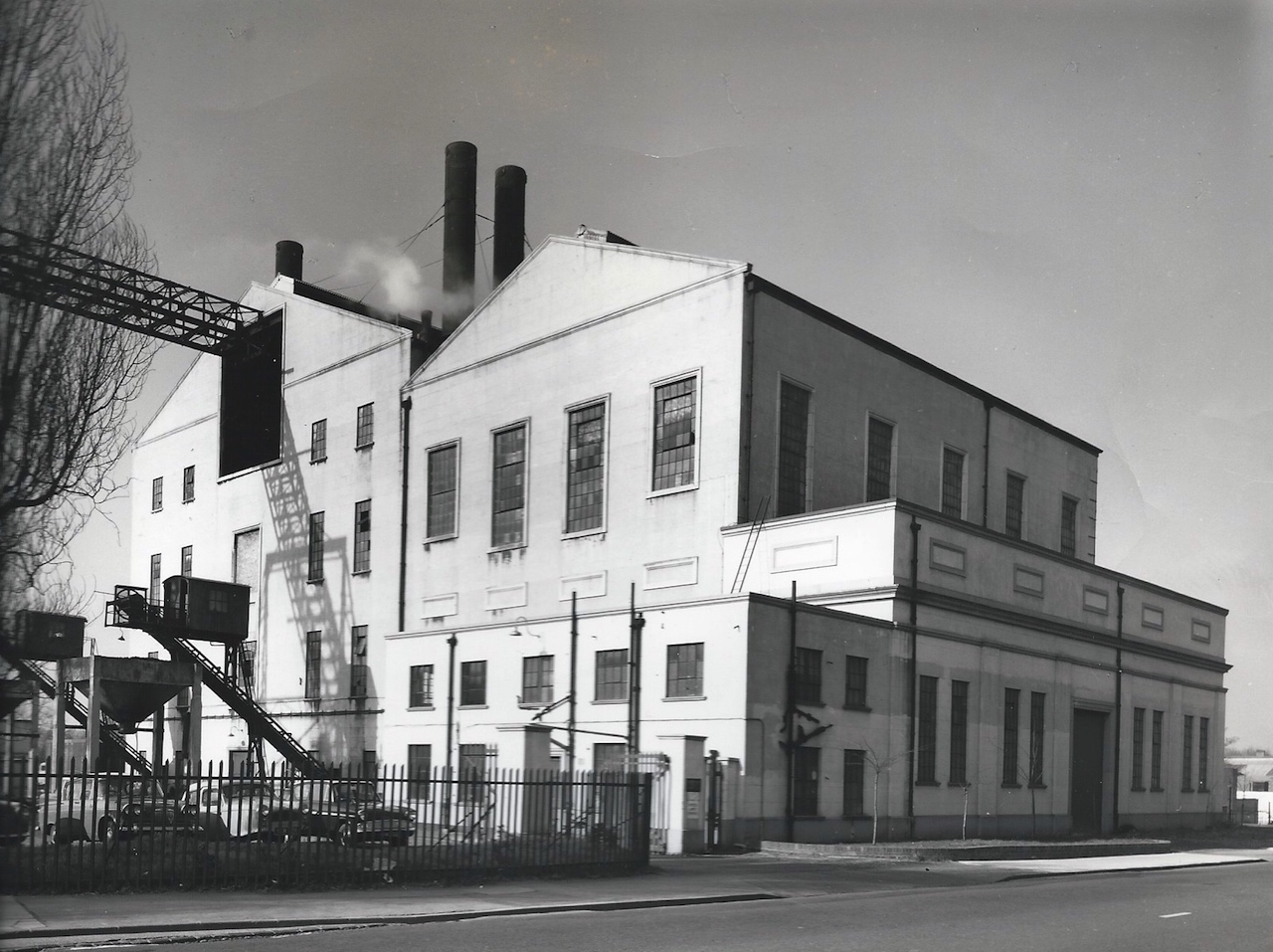

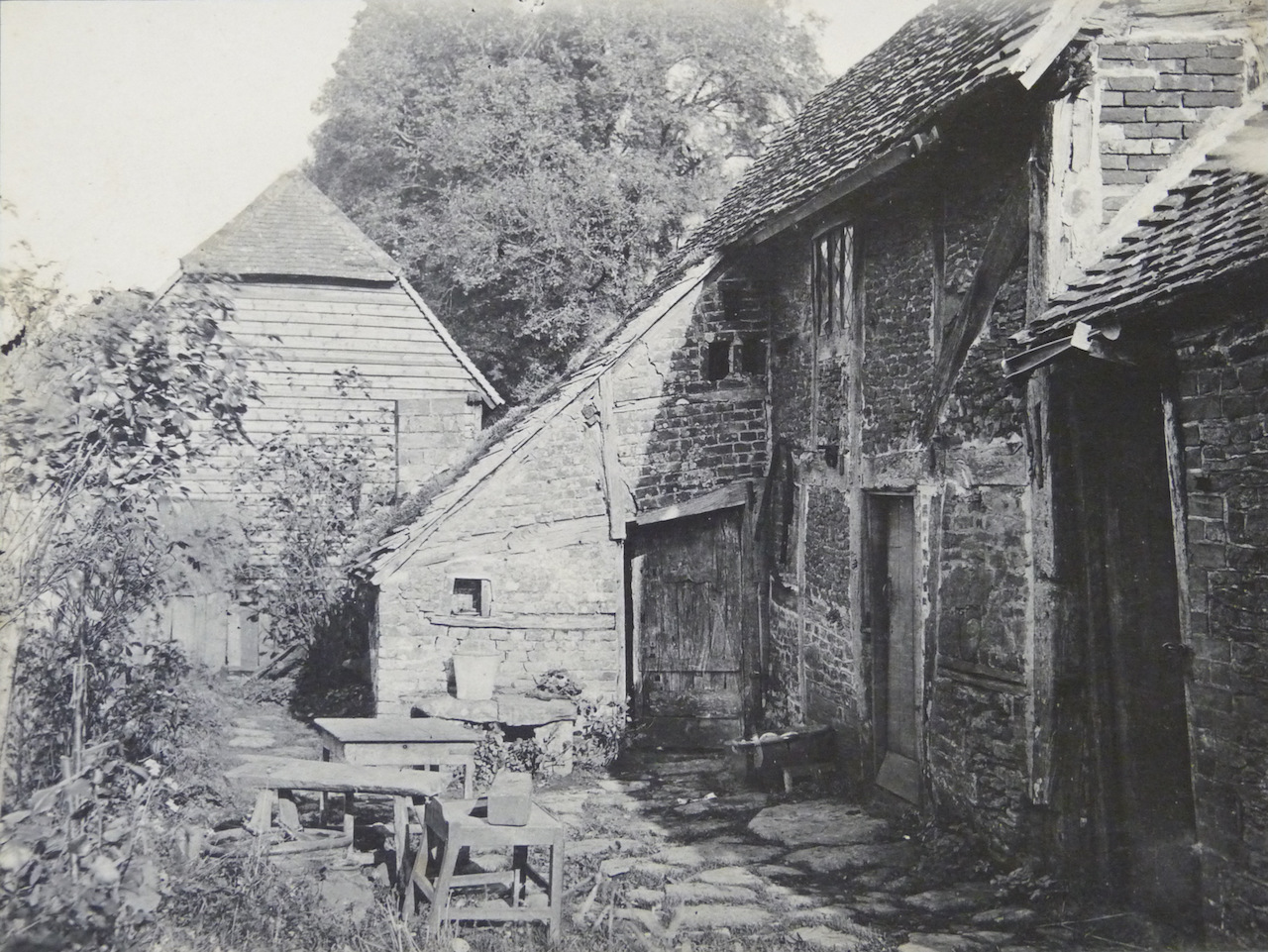







Jim Allen
February 28, 2021 at 10:07 pm
Interesting I wonder if the politics have changed as much as the now clean facade of present time
Mat Huth
March 1, 2021 at 11:58 am
Back then it was a few crap buildings like on these photos, but renovation should make them better looking.
That said, today we have much more ugly post-war architecture where renovation cant be helpful.
In my opinion Guildford should rebuild North Street church and the line of Victorian houses on the same street instead of ugly Barclays bank.
Nicholas Wright
March 1, 2021 at 5:07 pm
Born in Guildford in 1954, I moved away to study at university and have very rarely returned. I have always had a somewhat jaded opinion of my home town. I shall never return.
Barbara Ford
March 2, 2021 at 12:56 pm
Fascinating. It’s always good to be reminded not to sentimentalise the past – nor indeed poverty – just look at the smithy and the butcher’s.
David Roberts
March 2, 2021 at 4:46 pm
What’s wrong with horse dung? Better than plastic waste, PM10s and NO2 pollution any day.
Also, no light pollution and the butcher’s meat was all local and organic.
Graham Clarke
March 2, 2021 at 11:44 pm
The rather shambolic Park Street cottages pictured in the article weren’t all knocked down in the 1950s, as I remember with certainty frequenting one of them in 1961/62 when it was operating as a second-hand record store by the name of Record Rendezvous.
Barry Williams
March 3, 2021 at 9:55 am
Sadly, we are still a dirty town.
Traffic pollution aside (we see increasing numbers of idling parked cars whilst the driver uses their mobile phone); there is a growing tide of litter in our streets, hedgerows, trackways, and parks with empty bottles, cans, fast-food packaging and bags of dog pooh either left in collective piles or hanging on trees (mindless!).
Not only physical litter, also spray paint graffiti litter in the form of “tags” in public and private areas, and on historic buildings that seemingly promote the “tagger’s” area – much like a dog marks its territory – and to what purpose?
The graffiti also includes a very large one promoting the website of an infamous conspiracy theorist and anti-vaxer, which is to be found on a wall by the riverside adjacent to Guildford Rowing Club. GBC or NT please note can you remove this please?
David Raison
March 5, 2021 at 10:35 am
A really interesting piece by David Rose.
I have a particular interest in the picture of the forge, as I painted my version of it a few years ago.